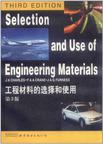工程材料的选择和使用
1970-1
世界图书出版公司北京
J.A.Charles等[
《工程材料的选择和使用(英文版)(第3版)》内容简介:The continuing success of this book has required reprints of the second edition, and now a third edition. In its preparation great attention has been paid to the invaluable comments made by reviewers and users of the earlier editions. The continuing development of design engineering, the growing importance of plastics, ceramics and composite materials, has required additional text and rewriting in many chapters. Also, since the second edition, there has been a marked growth in the availability of materials databases and in computerized materials selectors. Thus Chapter 14, on the formalization of selection procedures, has been substantially modified to take account of this. Other new features are the explanation of the Weibull modulus in describing the variability of strength to be expected in a material, materials for springs and the influence of hydrogen on the performance of steels and the relevance to sour gas service in the petroleum industry.
preface to the third editionpreface to the second edition preface to the first edition the background to decision 1 introduction 2 motivation for selection 2.1 new product development 2.2 improvement of an existing product 2.3 problem situations and constraints on choice 3 cost basis for selection 3.1 cost-effectiveness and value analysis 3.2 analysis of cost 4 establishment of service requirements and failure analysis 4.1 selection and design in relation to anticipated service 4.2 the causes of failure in service 4.3 the mechanisms of failure 4.4 corrosion 5 specifications and quality control 5.1 the role of standard specifications 5.2 inspection and quality control selection for mechanical properties 6 static strength 6.1 the strength of metals 6.2 the strength of thermoplastics 6.3 the strength of fibre-reinforced composites 6.4 cement and concrete 6.5 the strength of wood 6.6 materials selection criteria for static strength 7 toughness 7.1 the meaning of toughness 7.2 the assessment of toughness 7.3 fracture mechanics 7.4 general yielding fracture mechanics 7.5 toughness in polymers and adhesives 7.6 materials selection for toughness 8 stiffness 8.1 the importance of stiffness 8.2 the stiffness of materials 8.3 the stiffness of sections 8.4 materials selection criteria for stiffness 8.5 comparison of materials selection criteria 9 fatigue 9.1 micromechanisms of fatigue in metals 9.2 the assessment of fatigue resistance 9.3 factors influencing fatigue of metals 9.4 fatigue of non-metallic materials 9.5 materials selection for fatigue resistance 10 creep and temperature resistance 10.1 the evaluation of creep 10.2 the nature of creep 10.3 the development of creep-resisting alloys 10.4 the service temperatures of engineering materials 10.5 the selection of materials for creep resistance 10.6 deformation mechanism diagrams selection for surface durability .. 11 selection for corrosion resistance 11.1 the nature of the corrosion process 11.2 the problem of hydrogen embrittlement of steel 11.3 the selection of materials for resistance to atmospheric corrosion 11.4 the selection of materials for resistance to oxidation at elevated temperatures 11.5 the selection of materials for resistance to corrosion in the soil 11.6 the selection of materials for resistance to corrosion in water 11.7 the selection of materials for chemical plant 11.8 the degradation of polymeric materials 12 selection of materials for resistance to wear 12.1 the mechanisms of wear 12.2 the effect of environment on wear 12.3 surface treatment to reduce wear 12.4 wear-resistant polymers 12.5 erosive wear 12.6 selection of materials for resistance to erosive wear 13 the relationship between materials selection and materials processing 13.1 the purpose of materials processing 13.2 the background to process selection 13.3 the casting of metals and alloys 13.4 wrought products 13.5 the processing of polymers 13.6 the processing of composites 13.7 fabrication from powder 13.8 fastening and joining 14 the formalization of selection procedures 14.1 materials databases case studies in materials selection 15 materials for airframes 15.1 principal characteristics of aircraft structures 15.2 property requirements of aircraft structures 15.3 requirements for high-speed flight 15.4 candidate materials for aircraft structures 16 materials for ship structures 16.1 the ship girder 16.2 factors influencing materials selection for ship hulls 16.3 materials of construction 17 materials for engines and power generation 17.1 internal combustion 17.2 external combustion 18 materials for automobile structures 18.1 the use of steel 18.2 the introduction of plastics 18.3 aluminium and its alloys 18.4 corrosion damage to automobiles 18.5 surface treatment of steel for car bodies 18.6 future trends in body construction and materials 18.7 exhaust systems 19 materials for bearings 19.1 rolling bearings 19.2 plain bearings 20 materials for springs 20.1 steels 20.2 non-ferrous springs 20.3 non-metallic springs 21 investigative case studies 21.1 electric chain saw (black & decker ltd.) 21.2 the sturmey archer gear 21.3 high-power gridded tube (english electric valve co. ltd.) 22 problems useful texts index
版权页:插图:A major factor in this area will be the quality ofmaintenance during use, for example,lubricahonor the renewal of corrosion protection where thishas been speafied or the adherence to instruc-tions concerning component replacement. Ander-son,2 quoting Holshouser and Mayner,3 instancesthe analysis of 230 laboratory reports on failedaircraft components where, in spite of the highstandard set by airline companies,102 could beattributed to improper maintenance(mostly tak-ing the form of undesirable changes in geometrysuch as nicks and gouges), 52 of these occumng asa result of a fatigue mechanism.In the identification of a cause of failure, so thatinformation can be fed back to design or manu-facturing control stages, it is, of course, firstnecessary to recognize the failure mecharusmand any relationship with the structure, compo-sihonal characterisXcs or design of the materialcomponent which may be revealed.
《工程材料的选择和使用(英文版)(第3版)》是由世界图书出版公司出版的。
